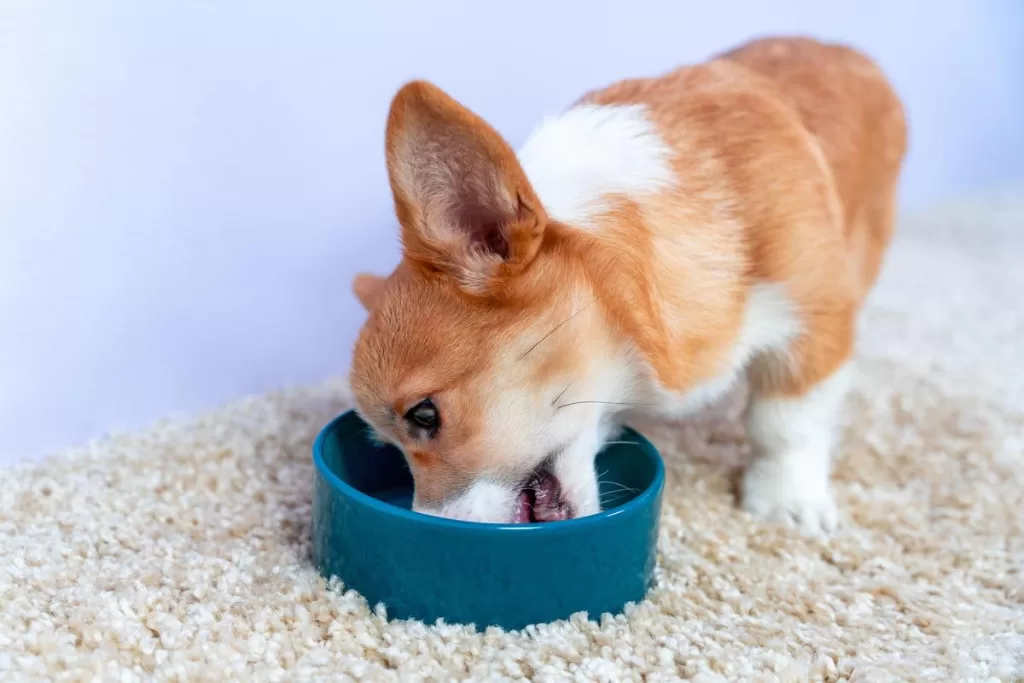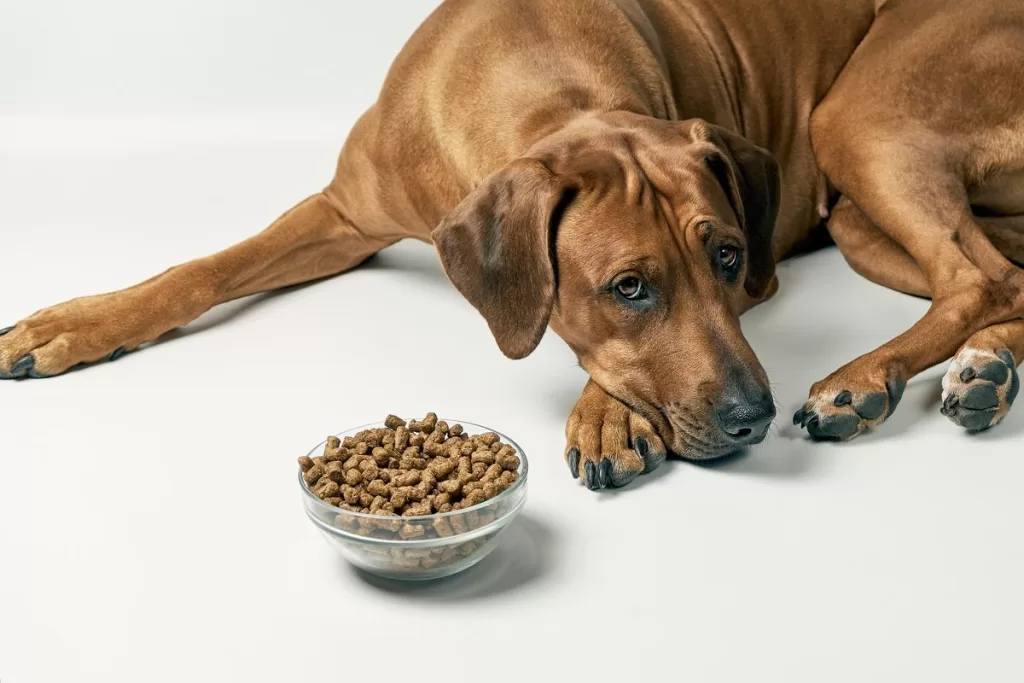Dog Isn’t Eating? As a responsible dog owner, it’s natural to be concerned when your beloved canine companion refuses to eat their food. Monitoring your dog’s eating habits is essential for their overall health and well-being.
Table of Contents
How long should you wait before worrying?

The amount of time you should wait before worrying depends on a few factors, including your dog’s age, health, and usual eating habits.
- Puppies: Puppies need to eat more frequently than adult dogs, so it’s important to be more proactive about addressing any feeding issues. If your puppy skips a meal, it’s a good idea to offer them a small snack or some wet food to see if they’ll eat. If they still refuse to eat after a few hours, it’s time to take them to the vet.
- Senior dogs: Senior dogs may have decreased appetites due to age-related changes. If your senior dog skips a meal, it’s not necessarily a cause for concern. However, if they’re not eating for several days in a row, it’s worth talking to your vet.
- Healthy adult dogs: Healthy adult dogs can usually go for a day or two without eating without any problems. However, if your dog skips more than two meals, it’s a good idea to start troubleshooting the issue.
Dog Isn’t Eating? What could be causing my dog not to eat?
Now let’s explore the crucial question: How long should you wait before worrying if your dog isn’t eating, and We’ll provide valuable insights and tips to address this concern effectively.
Also Read: How to Stop Dog Shedding Home Remedy
Average Eating Time
On average, a healthy dog should take about 10-20 minutes to eat their meal. However, it’s important to recognize that individual dogs may have varying eating speeds. Some may devour their food in seconds, while others may take a more leisurely approach. What’s crucial is understanding your dog’s usual eating pace.
Factors Affecting Eating Speed
Several factors can influence how quickly your dog consumes their food. These include:
- Medication: Some medications may affect your dog’s appetite. If your dog is on medication, consult your vet to understand if this might be the cause.
- Stress and Anxiety: Dogs can be sensitive to changes in their environment or routine. Stress and anxiety can lead to a decrease in appetite. Addressing the underlying stressors can help improve their eating habits.
- Health Issues: If your dog has an underlying health problem, such as dental issues or gastrointestinal discomfort, it may take them longer to eat or even deter them from eating. In such cases, consult your veterinarian for a proper diagnosis and treatment.
Encouraging Your Dog to Eat
To make your dog feel hungry and encourage them to eat, consider these strategies:
- Establish a Regular Feeding Schedule: Dogs thrive on routine. Feed your dog at the same times each day to help regulate their appetite.
- Use Food Puzzles or Interactive Toys: These can engage your dog’s mind and make mealtime more interesting. Fill these toys with a portion of their daily food to stimulate their appetite.
- Limit Snacking: Minimize the number of snacks and treats between meals to ensure your dog is hungry when it’s time to eat.
Consistently Refusing to Eat
If your dog consistently refuses to eat, even after trying the above strategies, it’s time to take action. Here’s what to do:
- Consult Your Veterinarian: Persistent refusal to eat can be a sign of an underlying health issue. Your vet can conduct a thorough examination to identify any problems and recommend the appropriate treatment.
- Check Food Quality: Ensure you’re feeding your dog a high-quality dog food that meets their specific dietary needs.
- Monitor Water Intake: Make sure your dog has access to clean, fresh water at all times, as dehydration can affect their appetite.
What can I do to encourage my dog to eat?

If your dog is not eating, there are a few things you can do to encourage them to eat:
Establish a Consistent Feeding Schedule
Feeding your dog at regular times and in a quiet, designated place can work wonders for their eating habits. Here’s why:
- Routine: Dogs thrive on routines. When you feed your dog at the same times every day, they become accustomed to the schedule, making mealtime predictable and reducing stress or anxiety associated with mealtime uncertainty.
- Quiet Environment: Choose a peaceful and low-traffic area for mealtime. This minimizes distractions and helps your dog focus on their food. Avoid feeding them in areas with high activity or near noisy appliances.
- Positive Association: Over time, your dog will associate this consistent routine with positive feelings, making them more eager to eat when it’s mealtime.
Offer a Variety of Foods
Just like humans, dogs can get tired of eating the same thing every day. Offering a variety of foods has several benefits:
- Maintains Interest: Introducing different flavors and textures keeps mealtime interesting for your dog. It can reignite their curiosity about what’s in their bowl.
- Balanced Diet: A varied diet can help ensure your dog receives a broader range of nutrients, which is beneficial for their overall health.
- Prevents Picky Eating: Rotating foods can help prevent your dog from becoming too selective or picky about their food. They are less likely to become fixated on one type of food.
Use Food Puzzles or Interactive Toys
Food puzzles and interactive toys can be a game-changer when it comes to making mealtime more engaging for your dog. Here’s why they work:
- Mental Stimulation: These toys challenge your dog’s problem-solving skills and provide mental stimulation. This can be especially helpful for intelligent or active breeds.
- Extended Mealtime: By dispensing food gradually as your dog interacts with the toy, it extends their mealtime, making it more satisfying.
- Fun and Distraction: Dogs enjoy the challenge and fun associated with these toys, which can take their minds off any stressors or anxieties related to mealtime.
Avoid Forcing Your Dog to Eat
Forcing your dog to eat is counterproductive and can lead to more eating issues down the line. Here’s why it’s essential not to do this:
- Creates Negative Associations: Forcing your dog to eat can make them associate mealtime with stress, fear, or discomfort. This can exacerbate their reluctance to eat in the future.
- Potential Health Risks: Forcing your dog to eat can cause choking, digestive problems, or even food aggression issues.
- Respect Your Dog’s Appetite: Dogs have different appetites, and it’s essential to respect their individual preferences. If they’re not eating, there’s likely a reason, and it’s better to address the underlying cause rather than forcing them to eat.
FAQs
If a dog is hungry, will they eventually eat?
If a dog is hungry, they will typically eat eventually. However, there can be various factors affecting their appetite, including health issues, stress, or changes in their environment. It’s essential to monitor your dog’s eating habits and consult a veterinarian if their refusal to eat persists, as it might signal an underlying problem. Offering a comfortable and consistent mealtime routine can help encourage your dog to eat when they are hungry.
What is the appropriate timeframe for concern if my dog ceases eating?
The appropriate timeframe for concern when your dog stops eating can vary depending on individual factors such as age, overall health, and the reason for their decreased appetite. In general, if your dog doesn’t eat for 24 hours or more, it’s advisable to consult your veterinarian. Prolonged refusal to eat may indicate an underlying issue that needs attention.
Is it acceptable for a dog to abstain from eating for 24 hours?
It is generally okay for a healthy dog to go without eating for up to 24 hours. Dogs can tolerate short periods without food, and it’s not unusual for them to skip a meal occasionally. However, if your dog’s appetite does not return after this timeframe or if there are other concerning symptoms, consult your vet for guidance.
At what point should I seek veterinary advice if my dog refuses to eat?
You should take your dog to the vet if they aren’t eating for an extended period, typically after 24 hours, or if you notice other concerning signs such as lethargy, vomiting, diarrhea, or noticeable weight loss. A veterinarian can perform a thorough examination to identify any underlying health issues and provide appropriate treatment or recommendations to address the problem.
How concerning is it when a dog doesn’t consume food?
A dog not eating can range from a minor, temporary issue to a more serious concern. The severity depends on the underlying cause. Dogs can go without food for a short time without significant harm, but prolonged refusal to eat may lead to nutritional deficiencies and weight loss. Therefore, it’s crucial to assess the situation based on the individual dog’s health and circumstances and seek professional advice if needed to ensure their well-being.
Wrapping Up
In summary, encouraging your dog to eat involves creating a positive and consistent mealtime routine, offering a variety of foods, adding fun and stimulation to mealtime, and always respecting your dog’s appetite and choices. By following these tips, you can help ensure your furry friend enjoys their meals and maintains good health.

